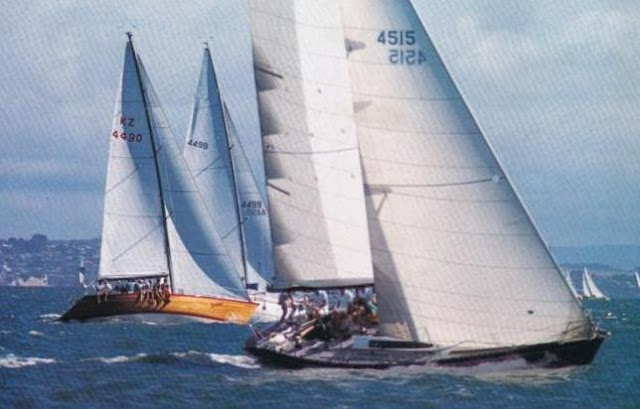 Following changes to the IOR that had penalised the wide sterns of the previous generation, Farr drew the first of his 1977 boats. This was a Three-Quarter Tonner named Joe Louis (Design 56), owned by French boxing champion Eric Simian and helmed by Flying Dutchman legend Yves Pajot.
Following changes to the IOR that had penalised the wide sterns of the previous generation, Farr drew the first of his 1977 boats. This was a Three-Quarter Tonner named Joe Louis (Design 56), owned by French boxing champion Eric Simian and helmed by Flying Dutchman legend Yves Pajot.Joe Louis was a fixed keeler, as at the time of her design it was expected that the centreboard loophole would be closed. There was also limited time available to design and build the yacht for the French Three-Quarter Ton trials. The design aimed to produce better all round performance than Farr's earlier designs, with length traded for sail area (similar to the Whiting response). With more changes to the IOR in the measurement of the stern area Farr sought to design cleaner aft end shapes by cleaning up the after girth stations and coupled this with narrower sections. A more upright transom allowed for more deck space. The yachts' concept was a forerunner of Farr's champion centreboard designs that would soon follow.

 Joe Louis was an important transitional design as the first of a line of evolutionary designs tht were to follow, and because it was one of the earliest Farr yachts to be built in Kevlar and foam sandwich. This allowed a lower hull weight and for a high ballast ratio to be achieved (52%), although some internal ballast was removed to get the boat to the correct displacement. A small amount of ballast was also removed from the bottom of the keel to obtain the correct centre of gravity measurement.
Joe Louis was an important transitional design as the first of a line of evolutionary designs tht were to follow, and because it was one of the earliest Farr yachts to be built in Kevlar and foam sandwich. This allowed a lower hull weight and for a high ballast ratio to be achieved (52%), although some internal ballast was removed to get the boat to the correct displacement. A small amount of ballast was also removed from the bottom of the keel to obtain the correct centre of gravity measurement.Joe Louis made her debut at the La Rochelle Week regatta in May 1977 where she finished as overall winner. At the Three-Quarter Ton Cup in August 1977, also held in La Rochelle, she came up against the lightweight Oesophage Boogie, designed by Jean Berret, and Drakkar, a centreboarder designed by Joubert & Nivelt, both very light and of wide beam. Drakkar was fast but lost its rig in the third race. Oesophage Boogie was also fast but lost out by doing poorly in the final light airs race. Joe Louis put in a more consistent performance, and although she won just one race she won the Three-Quarter Ton Cup comfortably. She was at least competitive in light weather, and demonstrated superior speed in windy conditions.
A production version of Joe Louis was to have been manufactured in England, but these plans had to be abandoned when the changes to the IOR took effect in 1978, raising Joe Louis' rating beyond the 24.5ft limit of the Three-Quarter Ton class (by a full 1.5ft). Staying in class was impossible to achieve while still maintaining good all round performance.
.jpg)
.jpg) |
.jpg)




.jpg)
.jpg)
































.jpg)









